

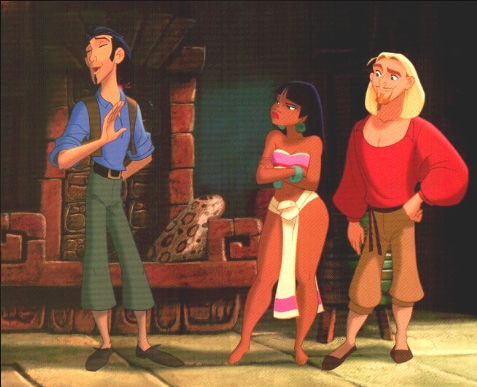 Directed
by: Bibo Bergeron & Will Finn
Directed
by: Bibo Bergeron & Will Finn
Written by: Ted Elliott & Terry Rossio
Music: Hans Zimmer, Elton John & Tim Rice
Production Start Date: July 14, 1997
Released on: March 31, 2000
Running Time: 89 minutes
Budget: $95 million
U.S. Opening Weekend: $12.846 million
over 3,218 screens
Box-Office: $51 million in the U.S., $75
million worldwide
 |
 |
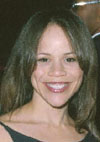 |
 |
 |
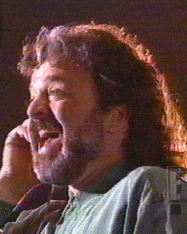 |
Miguel... Kenneth Branagh
Tulio... Kevin Kline
Chel... Rosie Perez
Tzekel-Kan... Armand Assante
The Chief... Edward James Olmos
Cortes... Jim Cummings
 |
 |
 |
![]() The Road to
El Dorado saw the widest release for a cartoon ever at the time, as
the film played in 3,218 theaters in the United States on its opening weekend.
The Road to
El Dorado saw the widest release for a cartoon ever at the time, as
the film played in 3,218 theaters in the United States on its opening weekend.
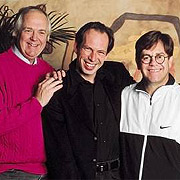
![]() It
reunites the Academy-Award winning musical team from The
Lion King. Its screenplay was developped by Aladdin's
writing team, and its setting is the same as Disney's upcoming The
Emperor's New Groove.
It
reunites the Academy-Award winning musical team from The
Lion King. Its screenplay was developped by Aladdin's
writing team, and its setting is the same as Disney's upcoming The
Emperor's New Groove.
![]() The
producers show Elton John and Tim Rice the story board of the movie, telling
them where they would need a song. Elton and Tim would then work
based on the plot -and Tim Rice had to rewrite the lyrics of the
songs several times, as the plot of the movie was changed, and the songs
moved from one scene to another. Elton John repeatedly joked afterwards
that he had the easy task of just writing the melodies!
The
producers show Elton John and Tim Rice the story board of the movie, telling
them where they would need a song. Elton and Tim would then work
based on the plot -and Tim Rice had to rewrite the lyrics of the
songs several times, as the plot of the movie was changed, and the songs
moved from one scene to another. Elton John repeatedly joked afterwards
that he had the easy task of just writing the melodies!
![]() Steven
Spielberg, Jeffery Katzenberg and David Geffen appointed him head of music
for DreamWorks SKG in 1997. Hans Zimmer now supervises the music for all
of the studio's films and television shows
Steven
Spielberg, Jeffery Katzenberg and David Geffen appointed him head of music
for DreamWorks SKG in 1997. Hans Zimmer now supervises the music for all
of the studio's films and television shows
![]() Kevin Kline
and Kenneth Brannagh recorded their parts together, which is unusual for
an animated movie.
Kevin Kline
and Kenneth Brannagh recorded their parts together, which is unusual for
an animated movie.

![]() The
movie was rated PG for mild thematic material and language.
The
movie was rated PG for mild thematic material and language.
![]() Many critics
pointed out the underlying but quite clear homoeroticism between the two
heroes of the movie. There is brief nudity in the film when lead
characters Tulio and Miguel skinny-dip in a hot spring tub. Other
equivocal gay scenes have been reportedly cut out of the animated feature.
Kenneth Branagh was quoted in Entertainment Weekly as saying: "There was
a lot of me saying to Tulio, 'What's the plan now, darling?' But
they cut the darlings out, actually."
Many critics
pointed out the underlying but quite clear homoeroticism between the two
heroes of the movie. There is brief nudity in the film when lead
characters Tulio and Miguel skinny-dip in a hot spring tub. Other
equivocal gay scenes have been reportedly cut out of the animated feature.
Kenneth Branagh was quoted in Entertainment Weekly as saying: "There was
a lot of me saying to Tulio, 'What's the plan now, darling?' But
they cut the darlings out, actually."
![]() In its
fourth weekend,
The Road to El Dorado plunged to thirteenth place,
earning only $2.0 million at 2,247 theaters, to bring its gross to $46.4
million. By contrast, Disney's Fantasia 2000, playing in only 53
Imax theaters, earned $2,141,916, to wind up in twelfth place.
In its
fourth weekend,
The Road to El Dorado plunged to thirteenth place,
earning only $2.0 million at 2,247 theaters, to bring its gross to $46.4
million. By contrast, Disney's Fantasia 2000, playing in only 53
Imax theaters, earned $2,141,916, to wind up in twelfth place.
![]() Jeffrey
Katzenberg admitted to Forbes in a February 2003 interview that "we knew
that we had El Dorado before the rest of the world knew we had El
Dorado. That was much harder for me than [asking a major DreamWorks
investor for a billion-dollar credit line]--to have a failure unlike nothing
I've experienced in 20 years. I've never had anything like that. That's
more humbling and humiliating than anything else that can happen."
Jeffrey
Katzenberg admitted to Forbes in a February 2003 interview that "we knew
that we had El Dorado before the rest of the world knew we had El
Dorado. That was much harder for me than [asking a major DreamWorks
investor for a billion-dollar credit line]--to have a failure unlike nothing
I've experienced in 20 years. I've never had anything like that. That's
more humbling and humiliating than anything else that can happen."
![]() The soundtrack
did not do well either in the United States: it failed to pass the symbolic
mark of 500,000 copies sold domestically, and peaked at the 61th spot of
the Billboard.
The soundtrack
did not do well either in the United States: it failed to pass the symbolic
mark of 500,000 copies sold domestically, and peaked at the 61th spot of
the Billboard.
![]() When you're
at a theater, if your bag of popcorn or soda cup has a movie logo on it,
that's because a studio paid for it through some barter deal. For The
Road to El Dorado, Dreamworks offered a free trip to South America
to the theater manager who created the best promotional gimmicks!
When you're
at a theater, if your bag of popcorn or soda cup has a movie logo on it,
that's because a studio paid for it through some barter deal. For The
Road to El Dorado, Dreamworks offered a free trip to South America
to the theater manager who created the best promotional gimmicks!
The Production ![]() The Music
The Music ![]() The Technology
The Technology ![]() Finding the El Dorado
Finding the El Dorado
 |
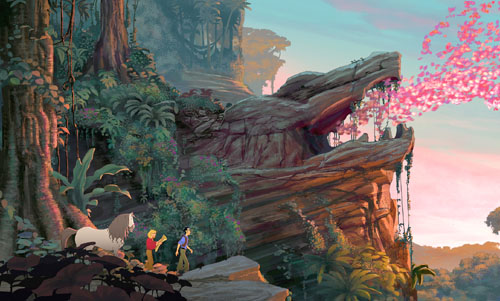 |
 |
The film, which took five years to make, initially started its production life as a drama. The idea was to gear the film towards adult tastes. Producer Bonnie Radford says, "We originally thought it would be rated PG-13 and so we skewed it to that group, but then we thought we could not exclude the younger kids so we had to tone the romance down." Chel's original wardrobe of sexy outfits was consequently made less revealing -though not enough to the taste of some extremist Latino groups who still found Chel's character offensive and stereotypical!
Progressively, the film evolved into a dramatic comedy, and finally a comedic buddy picture. According to senior supervising animator James Baxter, "It was challenging to keep your enthusiasm going in the face of having the story change. This story was a bit more changeable than [past features]. There was a lot of exploration about the kind of movie we were making."
 One
of the film's directors, Don Paul, explained that when he came on board
the production taking over from Will Finn and David Silverman after two
years of work, he found a demoralized crew even though the film's story
was finally starting to come together. Paul explains, "I came on board
at a point when a lot of the things were starting to gel. It was a long
[production] and so keeping any crew motivated is always tough... There
is a lot of dialogue in this film and that added a huge amount of complexity.
With an original story it's always more difficult to get it down."
One
of the film's directors, Don Paul, explained that when he came on board
the production taking over from Will Finn and David Silverman after two
years of work, he found a demoralized crew even though the film's story
was finally starting to come together. Paul explains, "I came on board
at a point when a lot of the things were starting to gel. It was a long
[production] and so keeping any crew motivated is always tough... There
is a lot of dialogue in this film and that added a huge amount of complexity.
With an original story it's always more difficult to get it down."
Jeffrey Katzenberg reveals that the central characters of Tulio and Miguel have their roots in the scene-stealing sidekicks found in virtually every animated favorite. "Having made these movies for a number of years now, I’ve always thought it would be a great idea to take what would ordinarily be the secondary characters—the dysfunctional losers, the comic relief—and send them off on some big adventure of their own."
"The flawed, but funny supporting characters are often the most interesting," director Don Paul concurs. "A main objective of this film was to break the mold of the typical heroic leading men with two scoundrels, who are anything but typical heroes."
The filmmakers add that the inspiration for Tulio and Miguel could also be found in the classic Hope & Crosby road movies and other popular buddy films over the years.
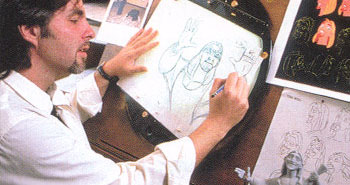 Producer
Brooke Breton notes, "We brought them together to record, which is unusual
in animation, and it was a delight. They had such a great time, and their
energy and creativity elevated each other’s performances." Adds Katzenberg:
"Kevin and Kenneth are such great talents and each have an incredible sense
of humor: Ken is very dry and witty; and Kevin is a natural comedian. They
had such terrific chemistry, and it was marvelous to put them together
and see what happened [several of Kevin Kline's ad libs were used in the
final version of the movie]. We were able to incorporate a lot of their
personalities in their characters, because, like Tulio and Miguel, they
are something of an odd couple."
Producer
Brooke Breton notes, "We brought them together to record, which is unusual
in animation, and it was a delight. They had such a great time, and their
energy and creativity elevated each other’s performances." Adds Katzenberg:
"Kevin and Kenneth are such great talents and each have an incredible sense
of humor: Ken is very dry and witty; and Kevin is a natural comedian. They
had such terrific chemistry, and it was marvelous to put them together
and see what happened [several of Kevin Kline's ad libs were used in the
final version of the movie]. We were able to incorporate a lot of their
personalities in their characters, because, like Tulio and Miguel, they
are something of an odd couple."
Rosie Perez appreciated the depiction of Chel as a woman indigenous to the Latin culture. "I think the filmmakers have done a wonderful job in being sensitive to the portrayal of Chel and other characters as Latinos. What they did was deal with her human side first before dealing with her outward appearance, and that’s so important. They approached the culture with a lot of respect. I think the Latin community is going to be very happy with this one, and it’s about time."
"This is my first animated film," Edward James Olmos (the Chief) says, "and the fun I had was phenomenal. It was exciting to build a character completely with just your voice. It’s liberating, rather than confining, because you have to really feel what the character is doing. Then the animators come in and have to develop the expressions from just your voice. It’s exciting to watch it come together."
In recording the dialogue for all the characters in The Road to El
Dorado, a lot of attention was paid to creating the kind of fast-paced,
overlapping dialogue that is typically more common to live action films.
Paul expounds, "We kept overlapping dialogue from one character to another,
which is not traditional in animation, but we really wanted to give the
banter between the characters a tighter rhythm. It boosted the energy and
gave a unique style to the film."
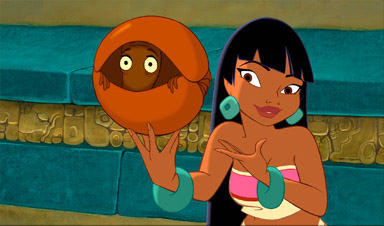 |
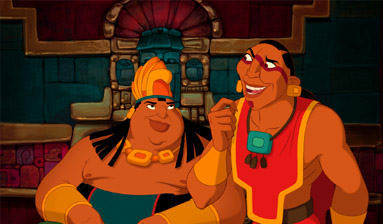 |
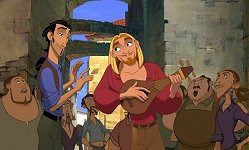 |
Jeffrey Katzenberg explains, "We wanted the songs sung by Elton to be the heart and soul of the movie—not only helping to tell the story, but revealing what’s happening beneath the surface. Having Elton, Tim and Hans together again on a movie is a dream for me. To get to work with these guys is a once-in-a-lifetime opportunity, so I feel extremely lucky that it’s happened to me twice.
"The reason I loved doing The Lion King and wanted to be a part of this film is the rapport I have with Jeffrey Katzenberg," Elton John says. "He’s inspirational; he makes me feel a part of the team, not just in terms of the music, but the film as a whole. He’s always willing to listen to what I think about the movie. Of course, then I have to let him say what he thinks about the music," John laughs. "I wanted to do another animated film," he continues. "Of course, I’m lucky. I write the melodies, so compared to Tim, I have the easy job. Animation is a long process—the story evolves, the jokes change, the songs switch scenes… and through all that, Tim is rewriting lyrics. But it was just delightful to work with Jeffrey, Tim and Hans again. We have tremendous respect for one another, so it was truly a team effort."
Zimmer also broke tradition by not using a full orchestra for much of the scoring. The characters’ individual themes are performed by small ensembles to achieve an intimate sound, as heard in Chel’s theme, aptly titled "Cheldorado." Gifted guitarist Heitor Pereira from Brazil, a former member of the rock group Simply Red, plays all the acoustic and Spanish guitar compositions in the film. In addition, Zimmer relates, "I saw this unbelievable group called Triology perform in Cologne. They have a sound like nobody else, and I knew they’d be perfect for this film. The hard part was telling Jeffrey that, instead of an orchestra, I wanted to use this avant-garde string trio I had found in Germany. My thinking was, ‘yes, we’re the team from The Lion King, but now let’s see who we can bring into this team and really make it different.’ I think it worked out really well."
Branagh remarks, "We both like to sing, and it was an incredible treat as an actor to be able to sing music by Elton John and the extremely witty lyrics of Tim Rice, and then to work with the brilliant Hans Zimmer in the studio. That sort of opportunity rarely comes along, so it was great fun to come into the recording studio and have a chance to play."
"[The song "Without Question" ] was originally written as a love song
between Tulio and Chel," John reveals, "but it also came to represent Miguel
falling in love with the place."
 |
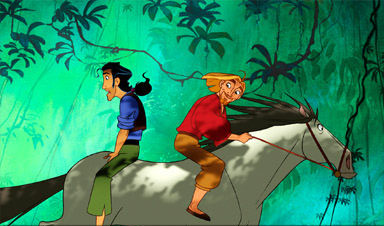 |
 |
There was a leap forward in 3-D animation crowd scenes in The Road to El Dorado. Paul explains, "Normally, your main and middle-ground characters are traditionally animated, and only the background characters are computer Generated. In this film, we have brought CG characters center stage, which is something I’m really proud of. We were very meticulous in modeling them so they would appear identical to the traditionally animated characters, and not look like they exist in different formats. The facial expressions and the performances of the CG characters are so much better than was done in the past. These are all stepping stones to bringing 3-D character animation to the forefront."
Another tool that was employed for the film was Elastic Reality Warp,
which has been used primarily in live action for morphing sequences. In
animation, it permits the artists to warp images to give the illusion of
subtle movement Without re-animating frame by frame. There
are myriad examples of ER Warp throughout The Road to El Dorado:
leaves bounce as Miguel hacks his way through the jungle; the sail of Cortes’
ship bends in the wind; Tulio’s back flinches as a leech is pulled from
it; and many more.
 |
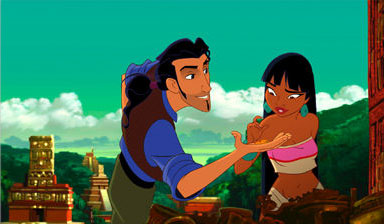 |
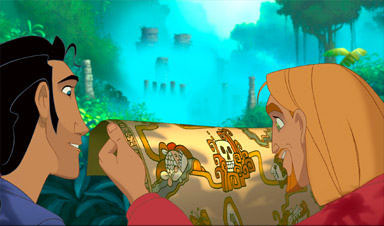 |
No one can say for certain whether El Dorado is pure invention or a myth borne of the truth, but the legend of this lost city of gold has endured for over 500 years.
For the filmmakers, the journey to El Dorado began with two research trips to the Yucatan Peninsula in Mexico. "A great deal of research went into this film, but we had to keep in mind that it’s set in a mythological place. A lot of the design was inspired by the Mayan civilization and other cultures, but it’s not meant to be an exact reflection of any one culture," Paul comments.
Bergeron expounds, "We wanted Spain to be almost monochromatic. Then, as Tulio and Miguel find their way through the jungle, we integrated more color as the characters discover a new world. Finally, when they come to El Dorado, we see every color of the rainbow."
Katzenberg concludes, "One of the most important things for me in making
an animated movie is to take the audience someplace they’ve never been
before. The inspiration for this story is a magnificent culture of which
only the tip of the iceberg still exists. It’s a world that once was…but
maybe if we could find that waterfall and make our way through it, we’d
find that El Dorado is still there and waiting for us."
|
||||||||||||